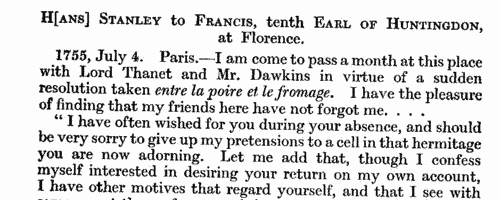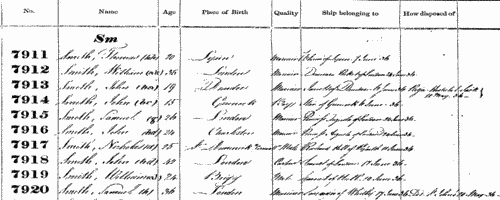Mcdonall Surname Ancestry ResultsOur indexes 1800-1900 include entries for the spelling 'mcdonall'. In the period you have requested, we have the following 7 records (displaying 1 to 7): Buy all | | | Get all 7 records to view, to save and print for £44.00 |
These sample scans are from the original record. You will get scans of the full pages or articles where the surname you searched for has been found. Your web browser may prevent the sample windows from opening; in this case please change your browser settings to allow pop-up windows from this site. Hastings and Rawdon family correspondence
(1724-1817)
John Harley of the Historical Manuscripts Commission was invited by Reginald Rawdon Hastings to examine his family's extensive archives at the Manor House, Ashby de la Zouche, in Leicestershire. Harley produced a detailed calendar, of which this is the third volume, published in 1934, Hastings himself having since died, and Harley having been killed at Gallipoli, the work being completed by his colleague, Francis Bickley. This volume covers two categories of the records: correspondence of the Hastings and Rawdon family 1724 to 1815; and letters of Warren Hastings, of Daylesford House, Worcestershire, to general Charles Hastings, afterwards sir Charles Hastings, bart.MCDONALL. Cost: £4.00.  | Sample scan, click to enlarge

| Prisoners at Maidstone
(1832)
The return from the County Gaol and House of Correction at Maidstone from 1 January to 31 December 1832 lists all prisoners (full name), place from whence committed, number of days detained in the year (before final commitment; after final commitment; and after conviction), and sentence, giving time of imprisonment (if any), or whether acquitted, discharged, executed, transported, whipped, or died in gaol.MCDONALL. Cost: £6.00.  | Sample scan, click to enlarge

|  British merchant seamen
(1835-1836) British merchant seamen
(1835-1836)
At this period, the foreign trade of ships plying to and from the British isles involved about 150,000 men on 15,000 ships; and the coasting trade about a quarter as many more. A large proportion of the seamen on these ships were British subjects, and so liable to be pressed for service in the Royal Navy; but there was no general register by which to identify them, so in 1835 parliament passed a Merchant Seamen's Registration Bill. Under this act this large register of British seamen was compiled, based on ships' crew lists gathered in British and Irish ports, and passed up to the registry in London. Each seaman was assigned a number, and the names were arranged in the register by first two letters of the surname (our sample scan shows one of the pages for 'Sm'); in addition, an attempt was made to separate out namesakes by giving the first instance of a name (a), the second (b), and so on. But no effective method was devised to prevent the same man being registered twice as he appeared in a second crew list; moreover, the original crew lists were clearly difficult for the registry clerks to copy, and some of the surname spellings appear to be corrupted. A parliamentary committee decided that the system devised did not answer the original problem, and this register was abandoned after less than two years: but it is an apparently comprehensive source for British merchant seamen in 1835 to 1836. The register records the number assigned to each man; his name; age; birthplace; quality (master, captain, mate, 2nd mate, mariner, seaman, fisherman, cook, carpenter, boy &c.); and the name and home port of his ship, with the date of the crew list (usually at the end of a voyage). Most of the men recorded were born in the British Isles, but not all (for instance, Charleston and Stockholm appear in the sample scan). The final column 'How disposed of' is rarely used, and indicates those instances where a man died, was discharged, or deserted his ship during the voyage.MCDONALL. Cost: £8.00.  | Sample scan, click to enlarge

|  Persons of standing recommending London police recruits
(1843-1857) Persons of standing recommending London police recruits
(1843-1857)
The Metropolitan Police Register of Joiners (MEPO 4/334) lists policemen joining the force 1 January 1843 to 1 April 1857 (warrant numbers 19893 to 35804). The register is alphabetical, in so far as the recruits are listed chronologically grouped under first letter of surname. It gives Date of Appointment, Name, Number of Warrant, Cause of Removal from Force (resigned, dismissed, promoted or died), and Date of Removal. Although the register was closed for new entrants at the end of 1842, the details of removals were always recorded, some being twenty or more years later. Those recruits not formerly in the police, the army, or some government department, were required to provide (normally) at least two letters of recommendation from persons of standing, and details of these are entered on the facing pages. Where a recruit was only recently arrived in the metropolis, the names and addresses of the recommenders can be invaluable for tracing where he came from. Those recruits not formerly in the police, the army, or some government department, were required to provide (normally) at least two letters of recommendation from persons of standing, and details of these are entered on the facing pages: the names in these are indexed here (the police recruits are indexed separately and not included here). Recruits transferred from other forces or rejoining the force did not normally need recommendations - in the latter case, former warrant numbers are given - but some recommendations are from police inspectors, even other constables. Recruits coming from the army sometimes have general military certificates of good conduct, but most often have a letter from their former commanding officer; recruits recommended by government departments (most often the Home Office) similarly have letters from the head of department. But the great majority of the names and addresses in these pages are of respectable citizens having some sort of personal acquaintance with the recruit. Where more than two recommendations were provided, the clerk would only record one or two, with the words 'and others'. Tradesmen are sometimes identified as such by their occupations; there are some gentry. Although the bulk of these names are from London and the home counties, a scattering are from further afield throughout Britain and Ireland. MCDONALL. Cost: £8.00.  | Sample scan, click to enlarge

|  British infantry fighting in China
(1860) British infantry fighting in China
(1860)
The China Medal was awarded to soldiers and sailors who took part in the prosecution of the war against the Chinese from 1856 to 1860. Separate clasps were awarded for men who had been in receipt of the China Medal of 1842; for being actually present at Canton on 28 and 29 December 1857, when that city was bombarded and finally captured; for being actually engaged in the operations which ceased with the first capture of the Taku Forts, 20 May 1858, and led to the Treaty of Tientsin; for being actually present at the capture of the Taku Forts 21 August 1860; and for being actually present before Pekin the day the gate of that city was given up to the allied (British and French) army, viz. on 13 October 1860. The 99th (Lanarkshire) Regiment of Foot, based at Cork, embarked for India in September 1858, and was transferred to China in 1860; moved to South Africa in 1865, and returned to England in 1869. The regiment took part in the capture of Pekin.MCDONALL. Cost: £8.00.  | Sample scan, click to enlarge

| Bankruptcies
(1883-1884)
Volume 76 of The Law Times, 'The Journal of The Law and The Lawyers', a weekly publication, runs from 3 November 1883 to 26 April 1884. Much of the journal is taken up with law reports, leading articles, &c., and the 'Solicitors' Department' contains several regular features of great interest. Lists of bankrupts, liquidations by arrangement, dividends and orders of discharge extracted from the London Gazette were published each week, and these have been indexed both for the principals and their solicitors.MCDONALL. Cost: £6.00.  | Sample scan, click to enlarge

| Bankrupts
(1884)
In accordance with the Bankruptcy Act of 1883, notices received by the Board of Trade were gazetted in tabular form by the Inspector-General in Bankruptcy. At each stage the record gives the debtor's name, address (often including former addresses), description (i. e., occupation), the name of the court, and the sequential number of the matter in that court for the year. The tables of Receiving Orders additionally give Date of Order, Date of Petition and Date of Public Examination; notices of First Meeting give Date of Meeting, Hour and Place; Adjudications give Date of Order, Date of Petition, Name of Trustee (if appointed) and Address of Trustee; Notices of Intended Dividend give Last Day for Receiving Proofs, Name of Trustee, and Address; Notices of Dividends give Amount per Pound, When Payable, and Where Payable; Applications for Debtor's Discharge state the Day fixed for Hearing; and notices of Appointment of Trustees give the Trustee's Name, Address, and Date of Certificate of Appointment. Any one debtor would normally appear in a number of these tables as his or her case proceeded over the months. These are the notices gazetted in 1884.
MCDONALL. Cost: £4.00.  | Sample scan, click to enlarge

|
Research your ancestry, family history, genealogy and one-name study by direct access to original records and archives indexed by surname.
|










